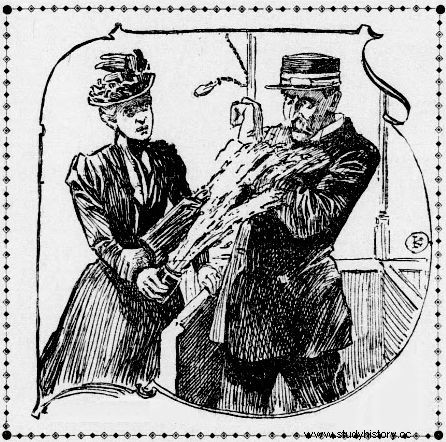Out of morbid jealousy, they were ready to disfigure and even kill the one who had rejected them. They were brutal, envious, obsessive. But the public did not believe any man could go as far as to act of cowardice ... apparently typical only for women.
The pre-war tabloids were full of stories of women who reacted to treason with hydrochloric acid ... pressed straight in the eyes of a rival or adulterous partner. In November 1932 alone, the popular local tabloid "The Last News of Krakow" described four such cases. The wife is hiding her husband with her lover? The latter takes out a corrosive substance and splashes it in the face. The fiancé chose a different one? Acid in the eyes as soon as they come off the wedding carpet. The beloved left the girl destitute? A known pattern:a bottle of acid hidden in a pocket, a sudden attack, severe "burns to the neck and face". There have been many similar cases.

The corrosive, deadly substances could be bought in any pharmacy, and even in a random commercial warehouse. The photo shows a pharmacy in Warsaw, 1938.
Sometimes a pot of boiling fat moved instead of acid. Sometimes things ended up going blind. "Illustrated Kuryer Codzienny" also paid a lot of attention to a woman who suddenly threw herself at the victim ... cutting off her tongue. In Lodz, in turn, it happened that the brutal fiancé was cooked in boiling lard. Or at least that's what the local tabloids said.
Go straight in the eyes
There was an opinion that only women were cowardly and hateful enough to be "hidden" in the eyes of a brawler. The Warsaw merchant in old goods, Srul Mucher, would rather disagree with this judgment. In August 1930, he poured acid on a certain Laja Kac. All because the woman was "insensitive to his courtship." However, Srul did not consider the location of the attack. He struck at a crowded bazaar, because it was there that his unfulfilled love worked as a stall maker. As a result - as reported by the daily "Slogan Podwawelskie" - "the crowd beat Srul into a sour apple, having previously poured the rest of the acid on his head".

It has been widely argued that only women are cowardly enough to use acid as a weapon. A photograph from the American press at the turn of the 19th and 20th centuries.
A similar attack, but at home, was carried out a year later by Antoni Mielniczek from Lviv. The fiancée gave him a basket because he was "without work", but she, as a cook, felt that she could pick and choose among the candidates. After all, she stood almost at the top of the domestic servant hierarchy. In reply, Mielniczek:“He came to [Anna] Michaniuk as usual and, without saying anything, poured hydrochloric acid over her face. The effects were fatal. Michaniuk lost her left eye and suffered a disfigurement on her face. ”
Before the court, the perpetrator explained that it was only an accident. The kvass allegedly "prepared for himself" and intended to drink it in front of his fiancée. However, when the girl started shouting at him that he should finally stop bothering her, and preferably completely "give her a room", the latter "got irritated and poured acid on her". The court sentenced him to a year and a half in prison.
Too indifferent to "all advances"
In the case of Mielniczka, it is possible to wonder whether the attack was caused by a broken heart, or rather - a lost opportunity for a profitable marriage. There was no room for any doubts in the case of Jan Majewski from Warsaw. Majewski had a friend, Antoni Kozietka. He had an attractive but also blindly devoted wife. When Kozietka was sent to military exercises in 1933, the self-proclaimed Don Juan went on the offensive. The straw widow, however, consistently responded "to all advances with indifference."

A pharmacy vial in a photo from the interwar period
When Majewski did not give her any peace, and he was getting more and more obtrusive, she "threw him out the door". A few days later the lover returned. He started in front of the house, and when Maria Majewska came out the door, "he poured sulfuric acid over her". As reported by "Express Illustrated", the woman had:"burned hands, breasts, neck and face, and a burned left eye".
Degenerates tormenting strange women
There were also attackers who did not know their victims at all. Or rather:these victims were unaware of the allegedly made acquaintance. In 1931, in Łódź, 50-year-old Anna Celary suffered a "general scalding" of the head, who was attacked with hydrochloric acid by an unidentified attacker. In turn, in Katowice and Królewska Huta, for several months at the turn of 1932 and 1933, a "mysterious individual" was prowling on various "exquisitely dressed ladies" fur coats and coats.
The murder weapon was again hydrochloric acid. In the course of a long investigation, a certain Maksymilian Niestrój was arrested. Local tabloids, such as the particularly offensive "Seven Pennies," had lynched him before the trial even began. There is nothing to feel sorry for, however. On the one hand, it turned out that he had been wrongly arrested and that he had nothing to do with the attacks on women he met by chance. On the other hand, it turned out that the man is a typical stalker, persecuting his ex-fiancée and threatening to "scratch her eyes sooner" than agree to break up.
